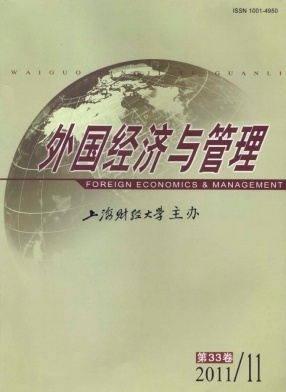国外团队社会网络研究回顾与展望:基于知识转移视角
外国经济与管理 2011 年 第 33 卷第 11 期, 页码:29 - 38
摘要
参考文献
摘要
本文介绍了团队社会网络的内涵与分类,概括了团队社会网络的构成要素与测量方法,回顾了团队社会网络对知识转移的作用模型,总结了各模型的特点与意义;在此基础上构建了基于知识转移视角的团队社会网络研究框架,以期系统揭示团队社会网络对知识转移的影响机理;最后指出了未来团队社会网络研究的三个方向。
[1]Adler,P S,and Kwon,S W.Social capital:Prospects for a new concept[J].Academy of Management Review,2002,27(1):17-40.
[2]Ancona,D G,and Caldwell,D F.Bridging the boundary:External activity and performance in organizational teams[J].Admi-nistrative Science Quarterly,1992,37(4):634-665.
[3]Bresman,H.External learning activities and team performance:A multimethod field study[J].Organization Science,2010,21(1):81-96.
[4]Faraj,S,and Yan,A.Boundary work in knowledge teams[J].Journal of Applied Psychology,2009,94(3):604-617.
[5]Hansen,M T.The search-transfer problem:The role of weak ties in sharing knowledge across organization subunits[J].Admi-nistrative Science Quarterly,1999,44(1):82-111.
[6]Hansen,M T.Knowledge networks:Explaining effective knowledge sharing in multiunit companies[J].Organization Science,2002,13(3):232-248.
[7]Hansen,M T,Mors,M L,and Lvs,B.Knowledge sharing in organizations:Multiple networks,multiple phases[J].Acade-my of Management Journal,2005,48(5):776-793.
[8]Krackhardt,D.The strength of strong ties:The importance of philos in organizations[A].in N Nohria,and R G Eccles(Eds.).Networks and organizations:Structure,form and action[C].Boston:Harvard Business School Press,1992:216-239.
[9]Lechner,C,Frankenberger,K,and Floyd,S W.Task contingencies in the curvilinear relationships between intergroup net-works and initiative performance[J].Academy of Management Journal,2010,53(4):865-889.
[10]Levin,D Z,and Cross,R.The strength of weak ties you can trust:The mediating role of trust in effective knowledge transfer[J].Management Science,2004,50(11):1 477-1 490.
[11]Marrone,J A.Team boundary spanning:A multilevel review of past research and proposals for the future[J].Journal of Ma-nagement,2010,36(4):911-940.
[12]Oh,H,Chung,M H,and Labianca,G.Group social capital and group effectiveness:The role of informal socializing ties[J].Academy of Management Journal,2004,47(6):860-875.
[13]Oh,H,Labianca,G,and Chung,M H.A multilevel model of group social capital[J].Academy of Management Review,2006,31(3):569-582.
[14]Reagans,R,and Zuckerman,E W.Networks,diversity,and productivity:The social capital of corporate R&D teams[J].Organization Science,2001,12(4):502-517.
[15]Robert,Jr,L P,Dennis,A R,and Ahuja,M K.Social capital and knowledge integration in digitally enabled teams[J].Infor-mation Systems Research,2008,19(3):314-334.
[16]Scott,J.Social networks:Critical concepts in sociology[M].New York:Routledge,2002.
[17]Sparrowe,R T,Liden,R C,Wayne,S J,and Kraimer,M L.Social networks and the performance of individuals and groups[J].Academy of Management Journal,2001,44(2):316-325.
[18]Tiwana,A.Do brigding ties complement strong ties?An empirical examination of alliance ambidexterity[J].Strategic Manage-ment Journal,2008,29(3):251-272.
[19]Tsai,W P.Knowledge transfer in intraorganizational networks:Effects of network position and absorptive capacity on businessunit innovation and performance[J].Academy of Management Journal,2001,44(5):996-1 004.
[20]Tsai,W,and Ghoshal,S.Social capital and value creation:An empirical study of intra-firm networks[J].Academy of Manage-ment Journal,1998,41(4):464-476.
[2]Ancona,D G,and Caldwell,D F.Bridging the boundary:External activity and performance in organizational teams[J].Admi-nistrative Science Quarterly,1992,37(4):634-665.
[3]Bresman,H.External learning activities and team performance:A multimethod field study[J].Organization Science,2010,21(1):81-96.
[4]Faraj,S,and Yan,A.Boundary work in knowledge teams[J].Journal of Applied Psychology,2009,94(3):604-617.
[5]Hansen,M T.The search-transfer problem:The role of weak ties in sharing knowledge across organization subunits[J].Admi-nistrative Science Quarterly,1999,44(1):82-111.
[6]Hansen,M T.Knowledge networks:Explaining effective knowledge sharing in multiunit companies[J].Organization Science,2002,13(3):232-248.
[7]Hansen,M T,Mors,M L,and Lvs,B.Knowledge sharing in organizations:Multiple networks,multiple phases[J].Acade-my of Management Journal,2005,48(5):776-793.
[8]Krackhardt,D.The strength of strong ties:The importance of philos in organizations[A].in N Nohria,and R G Eccles(Eds.).Networks and organizations:Structure,form and action[C].Boston:Harvard Business School Press,1992:216-239.
[9]Lechner,C,Frankenberger,K,and Floyd,S W.Task contingencies in the curvilinear relationships between intergroup net-works and initiative performance[J].Academy of Management Journal,2010,53(4):865-889.
[10]Levin,D Z,and Cross,R.The strength of weak ties you can trust:The mediating role of trust in effective knowledge transfer[J].Management Science,2004,50(11):1 477-1 490.
[11]Marrone,J A.Team boundary spanning:A multilevel review of past research and proposals for the future[J].Journal of Ma-nagement,2010,36(4):911-940.
[12]Oh,H,Chung,M H,and Labianca,G.Group social capital and group effectiveness:The role of informal socializing ties[J].Academy of Management Journal,2004,47(6):860-875.
[13]Oh,H,Labianca,G,and Chung,M H.A multilevel model of group social capital[J].Academy of Management Review,2006,31(3):569-582.
[14]Reagans,R,and Zuckerman,E W.Networks,diversity,and productivity:The social capital of corporate R&D teams[J].Organization Science,2001,12(4):502-517.
[15]Robert,Jr,L P,Dennis,A R,and Ahuja,M K.Social capital and knowledge integration in digitally enabled teams[J].Infor-mation Systems Research,2008,19(3):314-334.
[16]Scott,J.Social networks:Critical concepts in sociology[M].New York:Routledge,2002.
[17]Sparrowe,R T,Liden,R C,Wayne,S J,and Kraimer,M L.Social networks and the performance of individuals and groups[J].Academy of Management Journal,2001,44(2):316-325.
[18]Tiwana,A.Do brigding ties complement strong ties?An empirical examination of alliance ambidexterity[J].Strategic Manage-ment Journal,2008,29(3):251-272.
[19]Tsai,W P.Knowledge transfer in intraorganizational networks:Effects of network position and absorptive capacity on businessunit innovation and performance[J].Academy of Management Journal,2001,44(5):996-1 004.
[20]Tsai,W,and Ghoshal,S.Social capital and value creation:An empirical study of intra-firm networks[J].Academy of Manage-ment Journal,1998,41(4):464-476.
引用本文
徐伟青, 檀小兵, 奉小斌, 等. 国外团队社会网络研究回顾与展望:基于知识转移视角[J]. 外国经济与管理, 2011, 33(11): 29–38.
导出参考文献,格式为:
上一篇:国际创业研究演进探析及未来展望





 5966
5966  329
329

